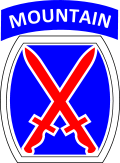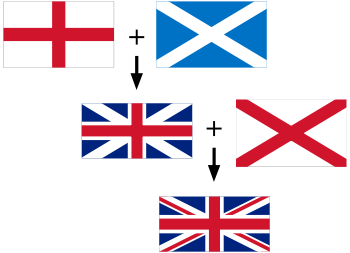Saltire
- St Andrew's Cross redirects here. For the item of BDSM furniture, see Saint Andrew's Cross (BDSM)
A saltire, Saint Andrew's Cross, or crux decussata (though it is never called the last in heraldry), is a heraldic symbol in the form of a diagonal cross or letter X. Saint Andrew is said to have been martyred on such a cross.
It forms the national Flag of Scotland and Flag of Jamaica, and appears on many other flags, arms and seals. It is also used as a traffic sign.
Christian symbol
The saltire appears on vexilla that are represented consistently on coinage of Christian emperors of Rome, from the fourth century. Anne Roes found it on coins of Constantius II, Valentinian, Jovian, Gratianus, Valens, Arcadius, Constantine III, Jovinus, Theodosius I, Eugenius and Theodosius II, though she searched only coins at the British Museum.[1] In the ninth and tenth century the saltire was revived in Constantinople as a symbol of Christian-imperial power. Anne Roes detected the symbol, which often appears with balls in the quadrants formed by the arms of the chi-cross, in standards represented on coins of Persepolis, and she suggested that early Christians endorsed its solar symbolism as appropriate to Christ, and suggested "although it cannot be proved, that in the white saltire of St. Andrew we still have a reminiscence of the old standard of the Persepolitan kingdom."[2]
Heraldry
|
A saltire is an X-shaped ordinary in heraldry. Like other ordinaries, a single saltire is throughout — extending to the edges of the field — unless it is blazoned as couped (cut off). When two or more saltires appear, they are necessarily couped, and need not be so described explicitly. It is sometimes refrred to in blazons as a 'cross of St Andrew': the coat of arms of Nova Scotia has been blazoned as 'Argent, a cross of St. Andrew azure, charged with an inescutcheon of the royal arms of Scotland'.
A saltorel is a narrow saltire; the term is usually defined as one-half the width of the saltire, and is a relatively recent "innovation". This is apparently different from a fillet saltire.

A field that is party per saltire is divided into four areas by x-shaped cuts. If two tinctures are specified, the first refers to the areas above and below the X, and the second refers to the ones on either side. Otherwise, each of the four divisions may be blazoned separately, the sequence being then top, left, right, bottom.
The phrase in saltire is used in two ways: to describe two charges, such as the keys in the arms of many entities associated with Saint Peter, crossing each other diagonally; or for five or more charges, one in the center and one or more on each arm of an invisible saltire.
Three saltires couped appear in the arms and flag of Amsterdam, and a saltire is used by a supporter of the royal arms of Scotland. The flag traditionally attributed to the Kingdom of Mercia was a gold saltire on a light blue background. Thus, Azure a saltire Or are now the arms of the City and District of St Albans.
Flags

The Flag of Scotland, called The Saltire or St Andrew's Cross, is a blue field with a white saltire; according to tradition, it represents Saint Andrew, who is supposed to have been crucified on a cross of that form (called a crux decussata) at Patras. The St Andrew's Cross was worn as a badge on hats in Scotland, on the day of the feast of St Andrew.[1] It is the oldest continuously used sovereign flag in the world, having been in use since AD 832 - or so legend has it.
Numerous flags are inspired by the saltire and the colours blue and white—mostly connected with Scotland or Russia, where Saint Andrew is the national patron saint. The naval ensign of the Imperial Russian (1696-1917) and Russian navies (1991-present) is a blue saltire on a white field. Prior to the Union the Royal Scots Navy used a red ensign incorporating the St Andrew's Cross. This ensign is now sometimes flown as part of an unofficial civil ensign in Scottish waters. The blue saltire on white design is featured on the Coat of Arms of Nova Scotia, Canada and its flag (Nova Scotia was originally a Scottish colony), but the blue used for Nova Scotia is generally a light blue. Similarly, the flags of the Spanish island of Tenerife and the remote Colombian islands of San Andrés and Providencia also use a white saltire on a blue field.

The Flag of Scotland forms one of the three crosses that are superimposed to form the Union Flag of the United Kingdom of Great Britain and Northern Ireland. (The other two are St George's Cross [representing England and Wales] and St Patrick's Cross [representing Ireland].)
Saltires are also seen in several other flags, including the flags of Grenada, Jamaica, Alabama, Florida, Jersey, Amsterdam, Potchefstroom and Valdivia. The design is also part of the Confederate Battle Flag and Naval Jack used during the American Civil War (see Flags of the Confederate States of America). William Porcher Miles, designer of the Confederate Battle Flag never claimed it to be a St. Andrew's cross design, but rather a heraldic saltire without religious symbolism.
Other uses
Signage

A saltire is the conventional road sign used to indicate the point at which a railway line intersects a road at a level crossing.
A white saltire on a blue background (or black on yellow for temporary signs) is displayed in UK railway signalling as a "cancelling indicator" for the Automatic Warning System or AWS, informing the driver that the received warning can be disregarded.
In Cameroon, a red "X" placed on illegally constructed buildings scheduled for demolition is occasionally referred to as a "St Andrew's Cross". It is usually accompanied by the letters "A.D." ("à détruire" - French for "to be demolished") and a date or deadline. During a campaign of urban renewal by the Yaounde Urban Council in Cameroon, the cross was popularly referred to as "Tsimi's Cross" after the Government Delegate to Yaounde Urban Council Gilbert Tsimi Evouna[3].
Gallery of saltires
See also
- X mark
- Gallery of flags by design
- Heraldry
- Cross
- Christian Cross
References
- ^ This article incorporates content from the 1728 Cyclopaedia, a publication in the public domain.
- ↑ Anne Roes, "An Iranian standard used as a Christian symbol", The Journal of Hellenic Studies, 57.2 (1937), pp. 248-51
- ↑ Roes 1937:251.
- ↑ Célestin Obama. Tsimi Evouna s’attaque aux édifices publics, Le Messager, 23 Sept 2008
|
||||||||